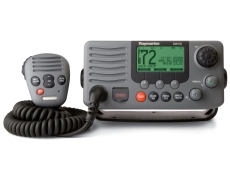Ray Marine Ray218 High Performance VHF Marine Radio
Product may not be held in stock or there's more details required to affect purchase.
Please click "MAKE AN INQUIRY" to initiate your order
The Ray Marine Ray218 is Raymarine's premier fixed-mount VHF marine radio.
Delivering exceptional performance and style, the Ray218 includes a long list of standard features including class D digital selective calling, a built-in hailer and chartplotter position polling.
Ray marine 218 Ocean, Uniden VHF, GME GX mobile, ray marine ray218, GX 18, DSC, 218, GME marine VHF radio. Uniden radios, Marine radios. Marine VHF radios for sale.
Calculate your shipping
You currently don't have any products in your cart.
For a shipping estimate on this product, please select your region from the dropdown.
Specifications
- Class D DSC (Digital Selective Calling) transceiver
- DSC distress key
- Built in 30 watt hailer with "listen back" capability and foghorn (automatic or manual)
- NMEA 0183 input with GPS position, COG and SOG display
- Chartplotter position polling using NMEA 0183 output
- Easy to use rotary controls for channel, volume, squelch and menu operation
- Extra large dot matric LCD
- Speaker microphone with controls and remote mount option
- Programmable favourite channel soft keys
- 4 scan modes: All scan, saved memory scan, priority all scan, and priority saved scan
- Quick access 16/9 key
- Submersible (IPX7 standard) ideal for marine use
- Superior receiver with excellent intermodulation rejection
Options
- Front and rear flush mounting
- External loudspeaker
FAQs - read more
Q. I saw an ad for two VHF radios for use in my business. Over how great a distance will these radios communicate?
A. VHF radios usually operate in the 1 to 2 watt range and sometimes up to as much as 5 watts output (but note that higher power levels will more quickly drain your batteries). The lower powered VHF radios might provide useful radio coverage at ground level over about 1 kilometre, assuming that one or both radio users are inside buildings or structures. Outside, coverage may be more than 2 kilometres if relatively free of obstacles.
Q. What if I need to talk over a greater range? I need to communicate over about 15 km with portable VHF radios-how can I do this?
A. A 5 watt VHF radio may give you a 15 km range in optimal conditions. i.e. No obstacles in between and clear atmospheric conditions. To gain more, It may be possible to use a telescoping antenna on a portable VHF radio, greatly increasing your usable range versus that provided with the short flexible antenna typical of most handheld, portable radios. You may also have the option of installing an outside antenna at one end of the link. Depending on your desired coverage area, you might see a 10 to 15 km range - or more if one end is high above the other and clear of obstacles. If you still need longer range, you should consider using a "repeater". A repeater is a specially built receiver and transmitter pair that receives signals from low power handheld or portable radios and retransmits them using a better antenna and more transmitter power. Consequently, the repeater can extend the range of a typical handheld by great distances. The actual distance depends on the system design and location. Where a repeater is located high atop a mountain, it may be possible to communicate to another station 160 kms away. For commercial users, you can rent use of an existing, shared repeater system. You can also enquire about using Specialized Mobile Radio Service (or SMR) systems that operate similar to the basic repeater and provide coverage over wide areas.
Q. What is the difference between a VHF radio and a UHF radio?
A. The terms "VHF" and "UHF" refer to parts of the radio spectrum. "VHF" refers to radio signals in the 30 Mhz to 300 Mhz range and includes many public safety and business communications systems; FM broadcasting, TV channels 2-13 and aviation radio. "UHF" refers to radio signals in the 300 Mhz to 3000 Mhz range. Until a decade or two ago, it was technically difficult or more expensive to build radios in this frequency range. As demand for radio usage has increased, the technology has improved and the costs of UHF radios have reduced so that VHF radio applications have moved or are moving to UHF. You will also find cellular phone service in this part of the radio spectrum; at the upper end you will find consumer microwave ovens and microwave "wireless cable" TV systems.
Q. Why should I use portable radios instead of cellular phones?
A. A cellular phone is ideal for making phone calls. It is not ideal for short range point to point communications since cellular is expensive. Further, if you need to make frequent short contacts, cellular requires that you dial the phone number and wait for the connection to be established, a delay of up to 30 seconds for every call that you make. With a portable radio you push the talk button and you talk without delay. If you need to have several people talking to each other at the same time, you can set up several two way radios on the same frequency. Each time one user speaks, everyone on the same frequency hears that person.
Q. How much power do I need in my two-way radio system?
A. How much power you need depends on how you plan to use the radio system. As a general rule, you should always use the least amount of power necessary to establish your communications. This reduces interference to other users (and they likewise reduce interference to you) when the radio frequency is used again in geographically local areas. Portable radios normally operate in the 1 watt to 5 watt range. Cellular phones dynamically adjust their power levels, according to directions from the local cellular base station. Handheld cellphones operate between 40 milliwatts and 600 milliwats (6/10ths of one watt); mobile cellular phones operate from 40 mw up to 3.0 watts.
Mobile two-way radio equipment operates, typically from 5 watts up to 50 watts, and sometimes as high as 100 watts output. The power level of the equipment is determined by the needs of the system.
 Please wait...
Please wait...




















